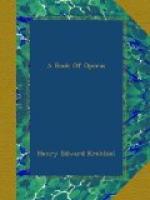The second scene reproduces the corresponding incident in Gounod’s opera—Faust in his study, life-weary and despondent. He is about to drink a cup of poison when the rear wall of the study rolls up and discloses the interior of a church with a kneeling congregation which chants the Easter canticle, “Christ is risen!” Here is one of the fine choral numbers of the work for which concert, not operatic, conditions are essential. The next scene, however, is of the opera operatic, and from that point of view the most perfect in the work. It discloses the revel of students, citizens, and soldiers in Auerbach’s cellar. Brander sings the song of the rat which by good living had developed a paunch “like Dr. Luther’s,” but died of poison laid by the cook. The drinkers shout a boisterous refrain after each stanza, and supplement the last with a mock-solemn “Requiescat in pace, Amen.” The phrase suggests new merriment to Brander, who calls for a fugue on the “Amen,” and the roisterers improvise one on the theme of the rat song, which calls out hearty commendation from Mephistopheles, and a reward in the shape of the song of the flea—a delightful piece of grotesquerie with its accompaniment suggestive of the skipping of the pestiferous little insect which is the subject of the song.
The next scene is the triumph of M. Gunsbourg, though for it he is indebted to Miss Loie Fuller and the inventor of the aerial ballet. In the conceit of Berlioz, Faust lies asleep on the bushy banks of the Elbe. Mephistopheles summons gnomes and sylphs to fill his mind with lovely fancies. They do their work so well as to entrance, not only Faust, but all who hear their strains, The instrumental ballet is a fairy waltz, a filmy musical fabric, seemingly woven of moonbeams and dewy cobwebs, over a pedal-point on the muted violoncellos, ending with drum taps and harmonics from the harp—one of the daintiest and most original orchestral effects imaginable. So dainty is the device, indeed, that one would think that nothing could come between it and the ears of the transported listeners without ruining the ethereal creation. But M. Gunsbourg’s fancy has accomplished the miraculous. Out of the river bank he constructs a floral bower rich as the magical




